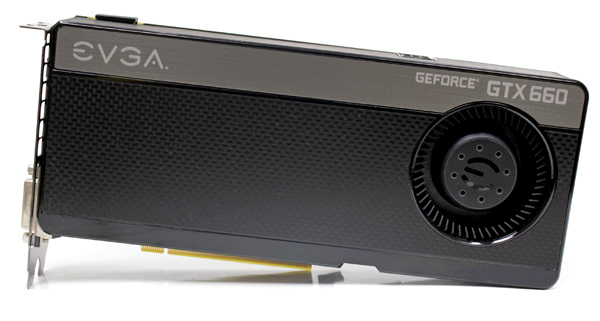Index


Review: 1920x1080 gamers' heaven
Today, Nvidia launches two new graphics cards – the GTX 660 and GTX 650. This completes the Geforce lineup which now top to bottom consists of:
Geforce GTX 690 (GK104)
Geforce GTX 680 (GK104)
Geforce GTX 670 (GK104)
Geforce GTX 660 Ti (GK104)
Geforce GTX 660 (GK106)
Geforce GTX 650 (GK107)
Geforce GT 640 (GK107)
Geforce GT 630 (re-branded Geforce GT 440)
Geforce GT 620
Geforce GT 610
Geforce 210
EVGA kindly provided us with its GTX 660 Superclocked 2GB whose GPU is overclocked from reference 980MHz to 1046MHz. The memory was left at reference 1502MHz (effectively 6000MHz GDDR5).

All the cards we’ve seen have custom cooling solution and although EVGA’s cooler looks a lot like the reference one, it actually received a performance boost, but we’ll talk more about that later.
GK106 is a new GPU based on Kepler architecture and specs suggest it may do well. It packs five SMX units with 960 CUDA cores, 24 ROPs and 80 texture units. The card has 2GB of GDDR5 memory and a 192-bit interface (three 64-bit memory controllers), sporting a bandwidth 144.2GB/s.

The Geforce GTX 660’s memory controller supports mixed density memory module operation. This feature allows to outfit the board with 2GB of memory (instead of 1.5GB) while utilazing a 192-bit memory interface.
The memory controller logic divides the GTX 660’s eight memory modules as follows:
Memory Controller 1: 4 pcs: 128M x 16 GDDR5 (1GB, 16-bit mode)
Memory Controller 2: 2 pcs: 64M x 32 GDDR5 (512MB, 32-bit mode)
Memory Controller 3: 2 pcs: 64M x 32 GDDR5 (512MB, 32-bit mode)
Unlike the GTX 650, GTX 660 has GPU Boost. The card’s reference Base clock is 980MHz, but the GPU overclocks to 1GHz+ when there’s thermal and power headroom. Boost clock is 1033MHz, but higher clocks are not uncommon. The GTX 660 has a 140W TDP so one 6-pin power connector did the trick. Under load GTX 660 typically draws 115W of power in most non-TDP apps.



